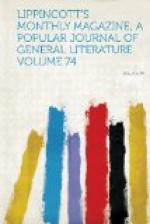There they saw the diamond put into harness by the Hindus and used for drilling gems as it is now for drilling railway tunnels. In the carpets and shawls of the same region was to be traced an exact and unfaltering instinct for color, the tints falling into their proper places like those of the rainbow—the result not a picture, any more than the rainbow is a picture, but a blotted study rubbed up with the palette-knife, or what in music would be a fantasia.
[Illustration: Munich exhibition building, 1854.]
From the Asiatic display, more complete by far than any before known, the eye passed to the works of the more disciplined hand and fancy and the more scholastic color-notions of Europe. There was young Munich with Mueller’s lions and the anti-realistic figures of Schwanthaler; Austria with Monti’s veiled heads, henceforth to be credited to Lombardy; Prussia with Rauch; and Denmark with Thorwaldsen—all pure form, copied without color from Nature, from convention and from the antique. Then came design and color united in ceramics—in the marvelously delicate flowers of Dresden, purified in the porcelain-furnace as by fire; in the stately vases of Sevres, just but varied in proportion, unfathomable in the rich depths of their ground-shadows, and exact and brilliant in the superimposed details; the more raw but promising efforts of Berlin, marked, like the jewelry from the same city, by faithful study of Nature; and, blending the decorative with the economic, the works of the English Wedgwoods and Mintons, infinite in variety of style and utility, and often pleasing in design. Italy, though supplying from her ancient stores so many of the models and so much of the inspiration of the countries named, seems to have forgotten Faenza and Etruria, and to prefer solid stone as a material to preparations of clay and flint. Her Venetian glass has markedly declined, at the same time that glass elsewhere—notably, the stained windows of Munich and the smaller objects of France and Bohemia—shows a great advance in perfection of manufacture and manageability for art purposes.
In that debatable land where the artistic and the convenient meet at the fire-side and the tea-table, English invention, enterprise and solicitude for the comfort and presentability of home shone conspicuous. Domestic art finds in the island a congenial home, and helps to make one for the islanders. English interiors, often incongruous and sombre in their decorations, at least produce the always pleasant sensation of physical comfort, the attainment of which the average Briton will class among the fine arts. Lovely as the Graces are, they need a little editing to harmonize them with a coal fire.




